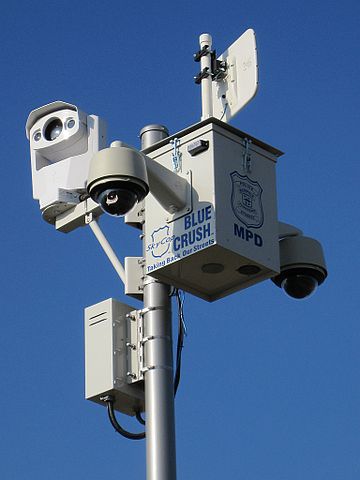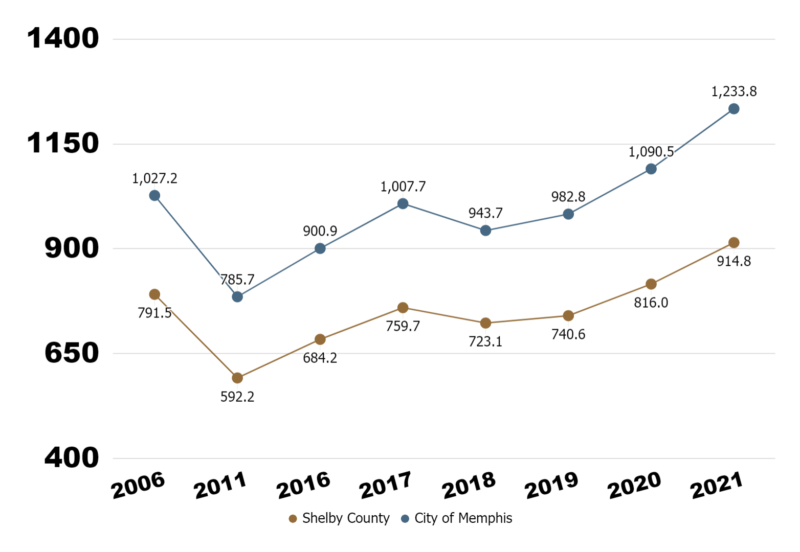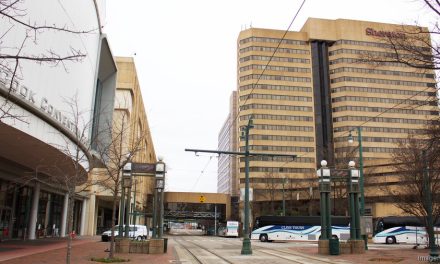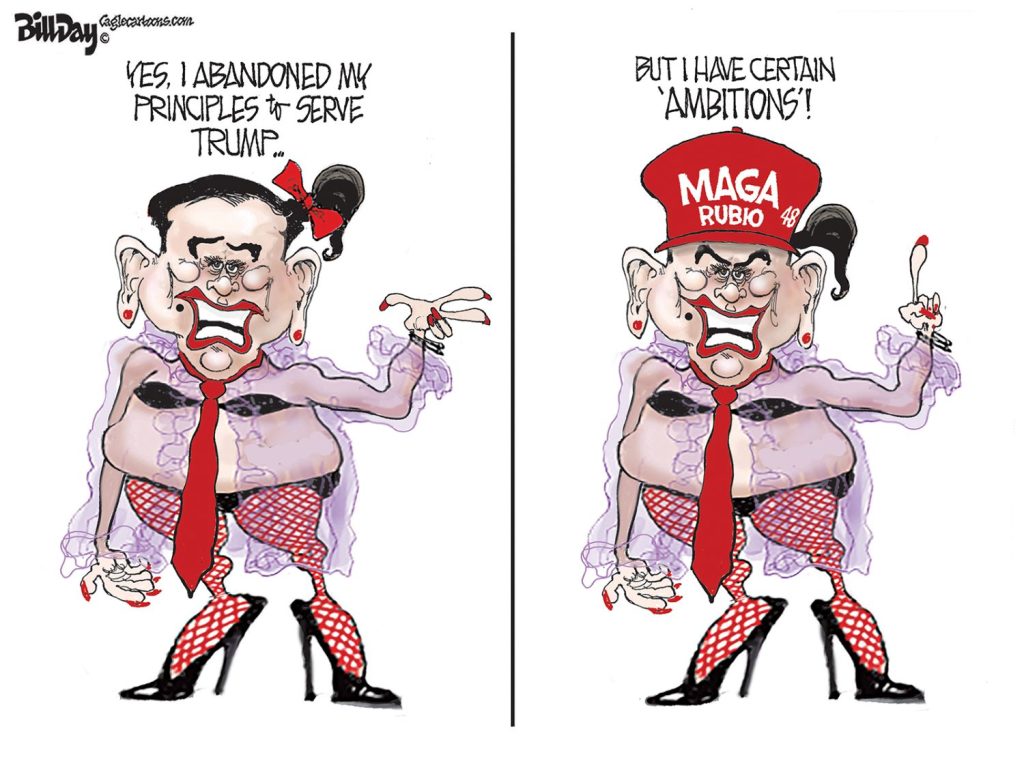Despite City of Memphis spending $10 million in a decade for more than 2,000 ubiquitous surveillance cameras, the violent crime rate in Memphis is 57% higher today than when the first surveillance cameras were installed.
As the Daily Memphis reported recently reported, the high visibility of the cameras, which are impossible to ignore with their flashing blue lights, were supposed to be a crime deterrent, however, data suggest they may be irrelevant in the battle against violent crime and some research even says that better lighting is more effective.
From January to June this year compared to the same period last year, violent crime is up 12.1%. The rate is now even higher than it was in 2006, the baseline year used by the Memphis-Shelby Crime Commission.
But by 2017, with Memphis Mayor Jim Strickland in the second year of a term in office that he won on the basis of a promise to reduce crime, started dramatically climbing and by 2020, the crime rate passed all previous years, including the 2006 baseline.
Are Cameras A Magic Answer?
The number of major violent crimes by year is:
6,836 – 2006
5,150 – 2011
5,883 – 2016
6,564 – 2017
6,150 – 2018
6,398 – 2019
7,085 – 2020
8,013 – 2021
Little Impact
All in all, it raises questions about the crime-fighting ecosystem’s solutions for reducing crime. It appears to have depended too much on strategies based on the orthodoxy of tougher enforcement, more prosecutions, longer sentences, and other traditional ideas while other cities have also pursued innovative programs about intervention and prevention.
As former Shelby County Mayor and Sheriff Mark Luttrell many times, our community is really good on suppression, or arrests, but not as good when it comes to intervention and prevention. However, rather than develop a more balanced approach to reducing crime, our community – and not just in this single area – regularly pursues magic answers like surveillance cameras.
Research raises questions about whether cameras are better deterrents than better lighting, but if cameras are to be used at all, they should be part of a comprehensive, creative approach to crime reduction
As the Daily Memphian reported, only one investigation into the 228 murders in 2021 even mentioned the cameras.
Nonprofits Have A Role
It is inarguable that reducing the crime rate is not only the responsibility of the police. Most of all, nonprofit organizations have a vital role to play, which suggests a more measurable, accountable approach to the dispersal of the $1.95 million by Memphis City Council to an array of nonprofits.
It’s hard to identify a thread that runs through the “community grants” and even harder to discern a Council philosophy behind what they are trying to accomplish. Rather, it feels like a scattershot program to sprinkle money all over Memphis to satisfy political, rather than policy, goals.
That’s too bad, because nonprofit organizations have the flexibility to be inventive and innovative and generally, they can leverage the money in a more efficient way.
Back to cameras. American cities like Memphis – following the example of countries like England – moved assertively in the wake of 9/11 to install millions of surveillance cameras on the presumptions that they reduce crime.
Chicago installed 15,000 cameras in one of the largest networks in the U.S., but across the U.S., millions of dollars are invested in CCTV systems without examining the costs and benefits of them, both financial and social, and without definitive research proving their effectiveness.
Street Lighting Benefits
Meanwhile, research suggests that better street lighting may be more effective at preventing crime than a CCTV network. There is also evidence that CCTV is most effective when combined with improved lighting and other crime reduction programs such as security guards and stepped-up policing.
A 2013 New York Times poll said 78% of the public support surveillance cameras in public places. Much of the research concluded that the cameras do little to prevent crime, and their value is more to the capture of criminals after the fact.
The evidence is that cameras do not reduce violent crime although they have been effective in reducing property crime, particularly parking lot and parking garage crime (although there is sometimes indications of displacement of crime other places).
A meta-analysis of the British research between 2000-2008 concluded that video surveillance had no statistically significant impact on crime. And yet, questions about effectiveness did little to slow down the growth in camera surveillance with the staggering number in England and Wales today standing at more than 4.2 million cameras.
Cameras Little Impact on Violent Crime
An internal Metropolitan Police report in 2009 said that more than one million CCTV cameras in London were involved in solving only 1,000 crimes. After reviewing extensive studies and research, the Municipal Technical Advisory Service (MTAS) of University of Tennessee’s Institute for Public Service concluded in 2017 that when CCTV is most effective, it is “when (it is) combined with other crime reducing/deterring methods such as improved lighting…” The California Research Bureau said in a 2008 that cameras should “not (be) a strategy in and of themselves.”
A Chicago spokesman said that surveillance cameras helped solve 4,500 crimes over four years, a time when more than a million crimes took place, setting the cameras’ contribution at .05% at best. The Office of the Independent Police Monitor in Chicago said that “the City of Chicago spent over $60 million of taxpayers’ dollars on (more than) 10,000 surveillance cameras, the presence of which have not conclusively proven to deter or reduce crime.”
A 2008 study of San Francisco’s cameras by the Center for Information Technology Research in the Interest of Society at University of California, Berkeley, said that they had a small impact on property crimes but no impact on violent crimes. A study that same year in Los Angeles by the University of Southern California School of Policy, Planning, and Development reported that in the two areas studied, there was no significant impact on crime from cameras in either place.
In a 2015 study in the Annual Review of Law and Social Science about other methods of crime reduction determined the following:
- CCTV is effective in car parks
- Improved lighting is effective in residential areas and city centers
- “Defensible space” method is effective in the “inner city”
- Some evidence of success by combining methods
- CCTV and improved street lighting are better for reducing property crime compared to violent crime
- Security guards in parking lots/garages are effective in reducing vehicle crimes
Blue Lights Mean Nothing
Generally, U.S. studies show little to no positive impact on crime reduction as a result of camera surveillance, and they make no distinction in the research between cameras and cameras with blue lights.
None of the studies include evidence that surveillance cameras with blue flashing lights increase safety, and there is anecdotal suggestions that the lights give the public the impression that they are in areas that are unsafe.
A 2007 report, “Crime Prevention and Hard Technology: The Case of CCTV and Improved Street Lighting,” in the book, The New Technology of Crime, Law, and Social Control, concluded that the assessment of both cameras and better street lighting found that street lighting was the more effective of the two. The Center for Problem-Oriented Policing at the University of Albany, in 2008, concluded: “Improved street lighting is widely thought to be an effective means of preventing crime, second in importance only to increased police presence. Indeed, residents in crime-ridden neighborhoods often demand that the lighting be improved, and recent research generally bears out their expectation that improved lighting does reduce crime.”
One study states flatly: “The capacity of street lighting to influence crime has now been satisfactorily settled,” adding that an advantage of better street lighting is that it is not seen as having the same privacy implications as CCTV.
Principles for Memphis
A 2010 document from the European Forum for Urban Security, “Charter for a Democratic Use of Video Surveillance,” sets out a set of principles and tools to ensure that citizens’ rights are respected with camera surveillance, including:
- Necessity: the use of cameras must be justified, ideally by an independent authority. Objectives and indeed outcomes must be defined.
- Proportionality: CCTV equipment must be appropriate for the problem it is intended to address. Technology should “respond to the established objectives without going further.” Data should be protected and the length of time it is retained clearly defined.
- Transparency: Citizens should know what the objectives of a CCTV system are, what its installation and operational costs are, the areas being surveyed, and what the results are. Reports should occur regularly so citizens can make informed decisions.
- Accountability: Those in charge of CCTV systems should be clearly identified and accountable to the public, whether the systems are run by the government or private firms.
- Independent oversight: An external body should be charged with ensuring that systems respect the public’s rights and are achieving their stated objectives. Ideally citizens would have a voice in the oversight process.
*****
- Join us at the Smart City Memphis Facebook pagefor daily articles, reports, and commentaries relevant to Memphis.






